Technological Development with an Awareness of Design Thinking and Real Users
Tohoku University of Art & Design
Professor SAKAI So
“Design Thinking” to facilitate problem solving
When developing new products, the use of keywords “xxx thinking” including design thinking has increased. We often see design as something related to sensitivity, perhaps because the word “design” is expressed in katakana characters in Japanese that are often used for words coming from other countries. However, theoretical use of design is actually not that new. In the 1960s, Herbert Simon, an American philosopher, wrote that design is a way of scientific thinking in his book “The Sciences of the Artificial.” Then in the 1980s the expression design thinking was described in “Design Thinking,” written by Peter Rowe. However, it was not until in the 2000s that even I, a design educator, started using the words frequently. Some time later, interest in design thinking grew rapidly in Japan and various workshops have been held. Today it is used not only by people involved in design, but also in technology and product development in various fields such as business and education.
Understanding the definition of users through UX
In design thinking, a problem is solved using a process modeled after the one in which designers perform design activities (Fig. 1). Designers always place users at the center when they think. It is important to consider what the users want and what would give them a sense of satisfaction and new value by solving what kind of problem or meeting what kind of requirement from their perspective. In recent years, we especially attach importance to UX (user experience), which is to focus on user experience value. This is similar to human-centered design in which technological development is carried out by putting humans who use a product at the center to respond to their needs instead of centering on the product. The difference between UX and human-centered design is that the latter is a structure to make a product from users’ point of view while the former focuses on the experience itself. By conducting examinations centering on the experience, we can see not only the case examples in simple bilateral B to C (Business to Consumers) relations between producers and providers of products and their consumers (Fig. 2) but also multiple other cases.

For example, a movie poster is created by a graphic designer and used by a company distributing the movie for an advertisement. In this case, we tend to think that the movie distributor is both the client and the user. However, the real users are people who want to see the movie. In order to sell the experience of a movie, a graphic designer is required not to just meet the demands of the movie distributor. The vital role of the designer is to make viewers feel interested in the movie. It is relatively easy to think about UX in the case of a movie of which the experience is used as a commercial product. However, in UX, the important aspect is to consider what experience a technology or product can bring about instead of thinking that a technology or product is built on the experience. Therefore, it is necessary to see users from multiple aspects.
This means not only to think of users as consumers including those who use a product, but also to include all the parties involved in a technology or product to be designed in users. In manufacturing for a B to B (Business to Business) business, in particular, it is often unclear who the product’s users are. When it comes to a copier for businesses, for example, the users are those who use it, of course, but there is also a person who manages equipment used in the office. Whether the equipment manager can easily manage paper, ink and other consumables affects the equipment’s usability. Equipment that is difficult to handle increases the burden on the manager. As shown in this example, the manager is one of the users, and the users also include companies involved in equipment maintenance and repair. Equipment with a structure that personnel in charge of maintenance can repair without difficulty is restored quickly with little waste. A copier, for instance, has various parties involved, and it needs to meet the requirements of these parties. One of the methods for this is to use an interface that is easy to understand. The word UI (User Interface) is often used and is a vital element in people’s lives. When seeing users’ perceptions from different points of view as in the case of a copier stated above, it is not only the interface for the copying function that counts, but also other aspects such as whether the manager can supply paper and replace ink easily, whether these methods are easy to understand and whether personnel in charge of maintenance and repair can operate it without difficulty and easily identify the area to be repaired. All these aspects related to people and products need to be regarded as an interface. This may be off topic, but it is also possible to consider that this Journal of IHI technologies, the Japanese version of this IHI Engineering Review, is an interface that connects the IHI Group’s technology with its users. In that sense, taking real users into consideration, it might be better to replace punctuation marks of “, (comma)” and “. (period)” with “ ” and “ ” in Japanese texts as the latter ones are used in Japanese in general. It is true that engineers are familiar with the former ones, and the use of “,” and “.” follows the “Procedure for Writing Official Texts,” which was defined by the Japanese Language Council (currently the Council for Cultural Affairs, Japanese Language Subcommittee) in 1952. (“,” and “ ” should be used in Japanese official texts according to the official rule, while the government started considering revising the rule in March 2021 so that “ ” and “ ” will be used in the texts.) Having said that, I would like to suggest that IHI should use punctuation marks with which people find it easy to read sentences and which can be easily identified if the technology described in the document is disclosed to the public as well as engineers. Originally, punctuation marks were not used in Japanese culture, and they started to be used in the Meiji period (1868–1912) so that anyone can read Japanese texts without any difficulty. Even today they are not used in some documents including certificates of commendation, which are to pay tribute to people. The use of such marks may be a trivial matter, but the reader’s impression changes whether or not you are aware of the reader when writing ordinary text.
Who are users for the IHI Group ?
For the IHI Group — a comprehensive heavy-industry manufacturer — who are its users or parties involved ?
When it comes to bridges such as the Seto-Ohashi Bridge and Akashi Kaikyo Bridge, it is possible to think of users as those who cross, manage and repair the bridge. In the cases of IoT equipment and logistics and transportation equipment used in a factory or plant, and of rocket business and power generation equipment, the scope of users tends to be unclear, and it is not easy to imagine what experience value the users want. As almost all commercial materials provided by the IHI Group are completed not by an individual party but through collaboration of multiple parties, it is necessary to see users as parties involved. In the field of manufacturing, even the words of parties involved may not be commonly used, and it may be unclear who they are. In such cases, we need to consider who is involved in the workflow of design and product development (Fig. 3).
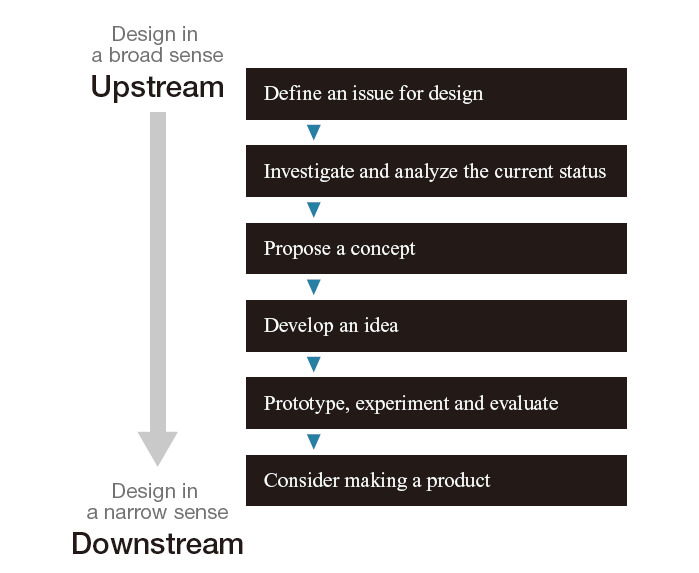
The value and technical specifications that are actually required become clear by clarifying relations between parties from the supply chain’s “upstream” on the orderer’s side to the “downstream” on the consumers’ side. As for me, I am ashamed to admit that despite being in the position of a designer and design educator, I tend to examine an excessive level of specifications when conceiving a new product as a researcher. This is to ensure that problems that might occur can be solved somehow while it may require wasteful costs to get fully insured. Products and services would be more available to the “downstream” side or real users by resetting the proper specifications. Of course, it is obvious that such proper specifications are better for the “upstream” side. In the field of technological development and manufacturing, both the orderer and consumers are often unclear, as stated above. It would become easy to create new value just by clarifying who the users are.
IHI is attempting to discover new users of technology by holding a workshop using design thinking several times as part of a business partnership with Tohoku University of Art & Design (TUAD) to which I belong (Figs. 4 and 5).
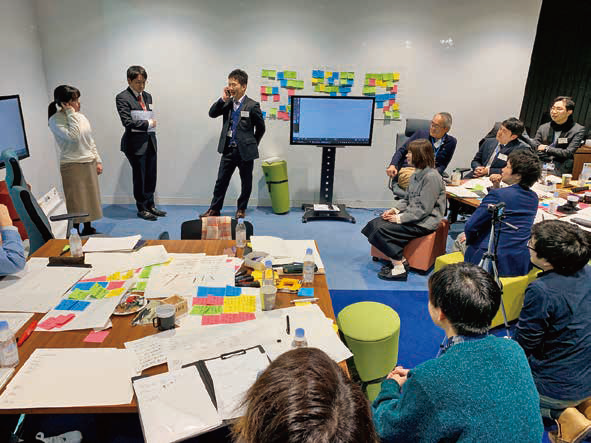
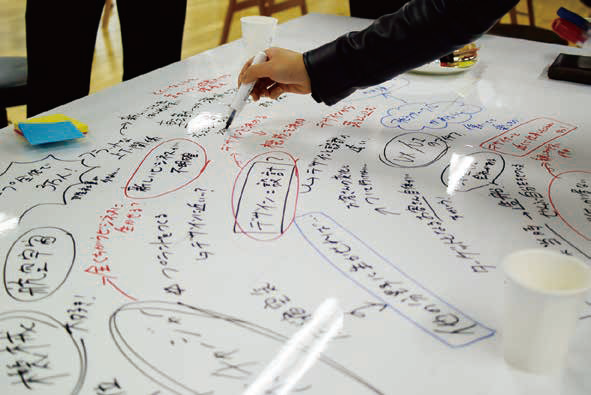
One of the features of design thinking is that it enables us to set a higher goal in the future with problem solving as the starting point. Specifically, this is to identify and solve problems through divergent thinking by simulating users and thinking from their perspective, and to conceive and create ideas to solve the problems to generate diversity beyond a goal that is already considered. We can then compile these multiple ideas through prototyping and verification to realize appropriate methods to solve problems. This is similar to the PDCA cycle in which the four steps of Plan, Do, Check and Act are repeated (Fig. 6), but the two methods are different in the sense that the latter is to think about how to solve clarified issues and problems while design thinking starts with defining an issue. In addition, the PDCA cycle forms a cycle of steps whereas in design thinking we can consider how to solve problems flexibly by reviewing various steps. This workshop was set up as place to experiment with methods to explore the potential usefulness of the value created by a product by identifying real users with students and quickly bringing ideas into shape as a product.

The following describes the details of activities conducted in fiscal 2018. The workshop was entitled “Think about New IHI with TUAD Students: Find the Real Customers! What Should be Done to Make Customers Feel Excited and Smile ?” The real customers refer to real users. Participants formed a group in which students and IHI engineers discussed how to delight real customers on an equal footing based on the IHI Group’s seeds of technology while focusing on regional challenges the Tohoku region faces. Three workshop sessions were held in three months and the participants made product proposals. In the initial session, they came to a mutual understanding of backgrounds including the culture of TUAD and the IHI Group, and IHI engineers introduced the Group’s technology. In the second session, participants considered the details of the proposal based on the technological seeds introduced in the first session. In the course of consideration, they mixed the technology and functions for the users’ needs and used a storytelling narrative to simulate specific scenarios in which the technology is used and imagine to what kind of customers (users) they would like to deliver the technology. The third session was to present deliverables, and during the interval between the second and third sessions, the participants made prototypes of products to be proposed with a simple dummy and CG, and created a video with which viewers can understand the scenarios in which the products are used and UX generated by the products.
The following three points were especially focused on as deliverables of the workshops:
- Consider using and applying existing technology owned by the IHI Group instead of developing a new technology.
- Focus on regional challenges of the Tohoku region that students are familiar with as the party involved. (The majority of TUAD students are from Tohoku, and they can easily identify the facts in local interviews.)
- Cherish UX generated from a product as well as its attraction and value.
The proposed products were visualized by the students to be those which can provide services to generate UX through giving the appearance of taking advantage of their functions and technologies of the IHI Group and adding functions to solve Tohoku’s regional issues (Fig. 7). This is the collaboration that was made thanks to the trust built between the students and IHI workers and their mutual understanding as true partners.
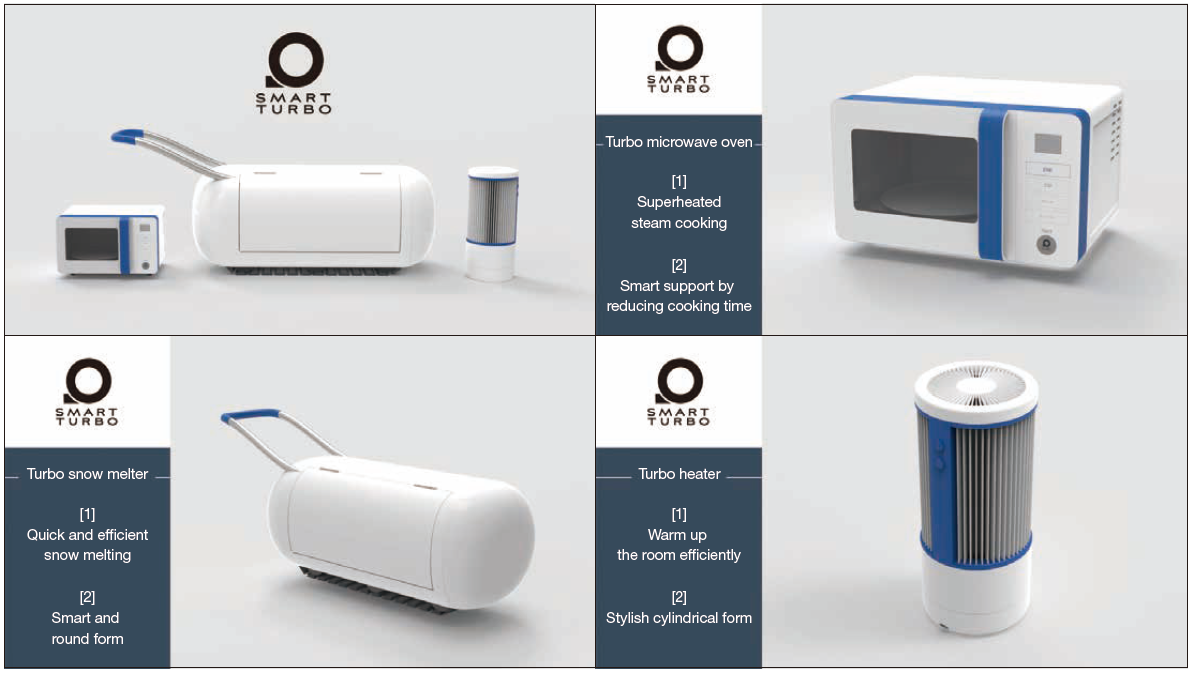
The style of design and technological development for the future
In this article, I mentioned that it is important to see users who are parties involved from multiple points of view, that we can discover new users by designing in consideration of the UX, and that design is useful in technological development. There have been more companies in and outside Japan that have realized the importance of defining design and technological development and established an in-house organization (center or department) carrying out design to practice design thinking. Furthermore, an increasing number of companies have assigned a CDO (Chief Design Officer), including Apple Inc. and IBM (International Business Machines Corporation). In Japan, Sony Group Corporation and Panasonic Corporation assigned an executive officer in charge of design. It is likely that there will be more companies carrying out design management and corporate reform utilizing the ability of designers who are highly capable of detecting, observing and empathizing with real users.
Professor Takahito Kamihira (Senshu University), an expert on information design, wrote in his book Co-Design: Giving Designing to Everyone’s Hands that “I do not regard people just as ‘users’ who use products but as ‘partners’ of design.” I would be grateful if many of you in and outside the IHI Group could be involved in creating new value and feel the usefulness of design as partners of the IHI Group or as users who are the parties involved.
PROFILE
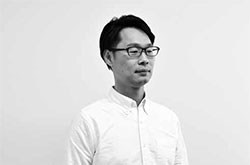
SAKAI So
Chairperson of Art Engineering Division, Design Engineering Division and Product Design Department, Professor/Ph.D. (art engineering) at Tohoku University of Art & Design Graduate School
Representative of SAKAI DESIGN STUDIO
Ph.D. of Art Engineering Research Department at Tohoku University of Art & Design Graduate School, former lecturer at National Institute of Technology, Sendai College, and professor of Product Design Department, Faculty of Design Engineering at Tohoku University of Art & Design at present.
In the doctoral course at Tohoku University of Art & Design Graduate School, he engaged in creative research activities with a research theme of “Researching expression with sensitivity made by coordinating sound, vibration and light.” Based on his expertise, he is now involved in the research and development of a new digital signage system and the research of automotive interior parts’ interfaces and other matters. One of his important works is “Addressable Screen project ‘Magical Card’ (at OSTEC Exhibition Hall).”
